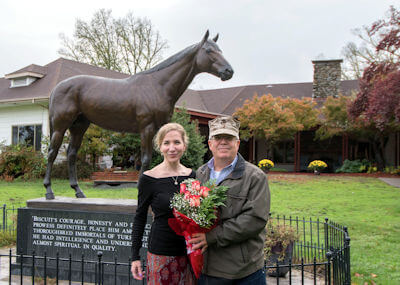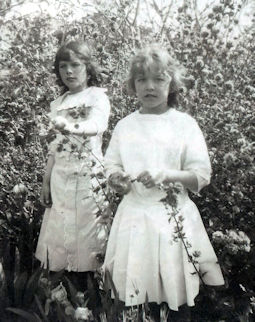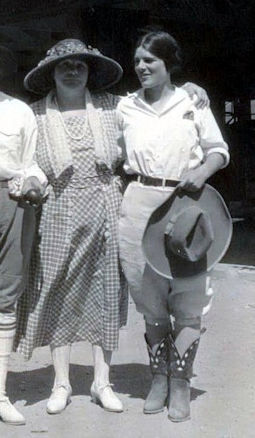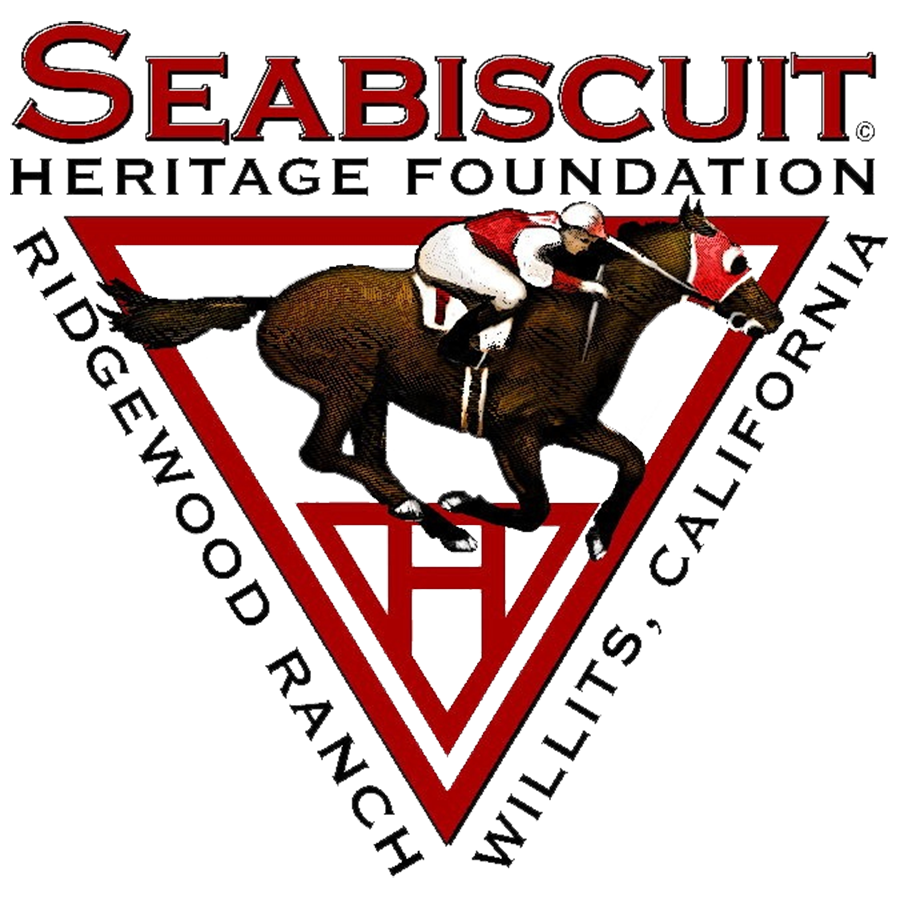How I Met Laura Hillenbrand
 Santa Anita Racetrack in Arcadia, California, has always been “sacred ground” to our Howard Family. My father Lindsay C. Howard Jr., grew up there watching his grandfather and father race horses there. Over the decades of the 1930s on into the 1990s, Howard horses found Santa Anita to be their second home. My Great Grandfather, Grandfather, father, and Aunt all raced strings of Thoroughbreds there. It was even joked within our family that the racetrack was really named after Anita Zabala Howard, my grandmother. Anita was an accomplished horsewoman and highly educated (I treasure the memories of her patience in teaching me as a child to read Swiss Family Robinson and Men to Match My Mountains). She was the younger sister of my Great Grandmother Marcela Zabala Howard, who actually owned Seabiscuit. Yes, the tricky park here is to realize that father and son (Charles S. Howard & son Lindsay Coleman Howard Sr.) married sisters: Marcela and Anita Zabala, of Salinas, California.
Santa Anita Racetrack in Arcadia, California, has always been “sacred ground” to our Howard Family. My father Lindsay C. Howard Jr., grew up there watching his grandfather and father race horses there. Over the decades of the 1930s on into the 1990s, Howard horses found Santa Anita to be their second home. My Great Grandfather, Grandfather, father, and Aunt all raced strings of Thoroughbreds there. It was even joked within our family that the racetrack was really named after Anita Zabala Howard, my grandmother. Anita was an accomplished horsewoman and highly educated (I treasure the memories of her patience in teaching me as a child to read Swiss Family Robinson and Men to Match My Mountains). She was the younger sister of my Great Grandmother Marcela Zabala Howard, who actually owned Seabiscuit. Yes, the tricky park here is to realize that father and son (Charles S. Howard & son Lindsay Coleman Howard Sr.) married sisters: Marcela and Anita Zabala, of Salinas, California.

Yes, my Dad loved Santa Anita in a very special way, claiming that it was more his home than any other location. Aside from his service as a US Marine in World War II, he was there as often as he could be. And all of his life, he reminded his children that he wanted to be buried there. When he passed away in 1996, he had horses stabled there (“My Turn at Bat” and “Take Your Base”) for the race meet. It was thus surreal and greatly appreciated by our family when the racing secretary graciously allowed us to have a private family & close friend’s memorial service at the beloved Seabiscuit statue. Santa Anita still has a special place in our hearts, as that is where my Dad’s ashes were spread.
There was, however, another very special and unpredictable blessing which resulted from Dad being buried at Santa Anita. Shortly after our family memorial, I received a call from the racing secretary sharing that she has received a call from someone wanting to interview me about our family history. Would I consider returning her call? When I returned the phone call, it was to a young woman in Washington D.C. named Laura Hillenbrand. We spend a long, positive period on the phone sharing our backgrounds and mutual love of history. I was impressed with her warm spirit, passion for history, and in particular her sharing that she considered herself a sports-writer, and the Howard story of Seabiscuit was in her opinion, the greatest sports story ever. I was impressed and humbled with her vision for sharing this old story in a new way. Like the closing scene in the 1942 Hollywood classic “Casablanca” – this was ‘the start of a beautiful friendship’.

I shared with Laura that as a Marine Corps officer, I was scheduled to leave my unit in Portland, Oregon (6th Engineer Support Battalion) and attend a Department of Defense Operations and Logistics conference at Ft McNair, in Washington DC, within a few weeks. We made plans to meet there, near her home. Before I left, we talked several more times by phone covering her plan to write an article about Seabiscuit for American Heritage. She noted that her hope was to call the article “Four Good Legs” based upon Red Pollard’s great line that when both he and Seabiscuit were badly injured in 1939, they still had “four good legs” between them!
Our first meeting was at the Chrystal City Marriott Hotel, where the Marine Corps had uncharacteristically billeted us at a nice DC hotel because the Bachelor Officer Quarters (BOQ) at Ft McNair was under reconstruction. I met Laura and her dear friend Borden Flanagan in the hotel lobby. We found a quiet corner and proceeded to delve into Howard racing history for two hours. She briefly excuse herself to attend the ladies room and it was then that Borden shared with me her medical challenges of struggling with Chronic Fatigue Syndrome and Vertigo. Little did I realize that within a few years, following 9-11, I too would be dealing with Vertigo and concussion issues following the close impact of an enemy Iraqi Seersucker cruise missile near my unit. What I will always really appreciate about Borden was the sensitive, loving manner in which he looked out for Laura. He graciously explained to me just how hard it was for her to just take the cab across town to make our interview. But that meeting me and being able to share in this story was so very important to her.
When Laura returned to our interview, we spent about another hour covering the areas that were important to her. I did my best to share what Marcela Howard (we affectionately called her “Auntie Mar”), my Dad, Grandfather, Grandmother Anita, and other uncles, aunts, and relatives had shared with me since I was a kid and could ask related questions I loved about family history and heritage. Laura was an amazing listener, and very organized in her thoughts and questioning. As I sensed that we were both tired but had accomplished a lot, we started to wrap things up. I had a special surprise that I wanted to share with her. I had it in a duffle bag and was planning on sharing it if things went well and I sensed that she could be trusted with it). I pulled out a large, red leather bound with silver edging, custom Howard racing album compiled by Marcela Howard. In it were letters, clippings, photos and other primary source materials relating to Seabiscuit. I handed it to her and watched the wonderful site of what she must have looked like as a little girl on Christmas morning! She was amazed as she carefully cradled it on her lap and slowly turned the pages. When she finally looked up, I said, “Would you be interested in the rest of them?” Again, her face was full of amazement as she asked “Others?” To which I smiled and replied: “Yes Laura, there are 23 more and I will send them all to you.”
Later, after she had used these for her research, we agreed that the best place for them was donation to the National Thoroughbred Museum of racing in Saratoga Springs, New York, close to where Charles & Marcela Howard first fell in love and purchased The Biscuit.
From this time on, Laura Hillenbrand was part of the Howard family. And she will always be a special friend of mine. During both of my combat tours in Iraq, she wrote and encouraged me often. She even send hundreds of copies of “Seabiscuit” in Arabic, which I was able to distribute to grateful Iraqis. Not only did I remind them of Seabiscuit’s Arab blood, but women were amazed at the fact that the author was also a woman. When I returned home, Laura graciously hosted Lynn and me in her home to make sure I was treated to two things I had missed the most in the harsh deserts of the Middle East: cold beer and cold ice cream! She then kindly booked us at her favorite hide-away on Chesapeake Bay. After all we had been through in her magnificent creative process of Seabiscuit, my gift to her was the 1903 Springfield .30-06 rifle that my Great Grandfather Charles Stewart Howard had given to Marcela. This she had used in Africa to shoot a lion, and many a deer at the family Ridgewood Ranch in Willits, California. On the plaque to which I attached her rifle, I added the brass plate: “Just in case you ever need to kill a lion.”
Her American Heritage article “Four Good Legs” was a tremendous success and led to her book “Seabiscuit”. The rest as they say, is History … but a very special and well deserved experience for Laura. As she later said to me after the film hit the big screen (using a track term jockeys use after a positive horse race): “What a Ride.”
